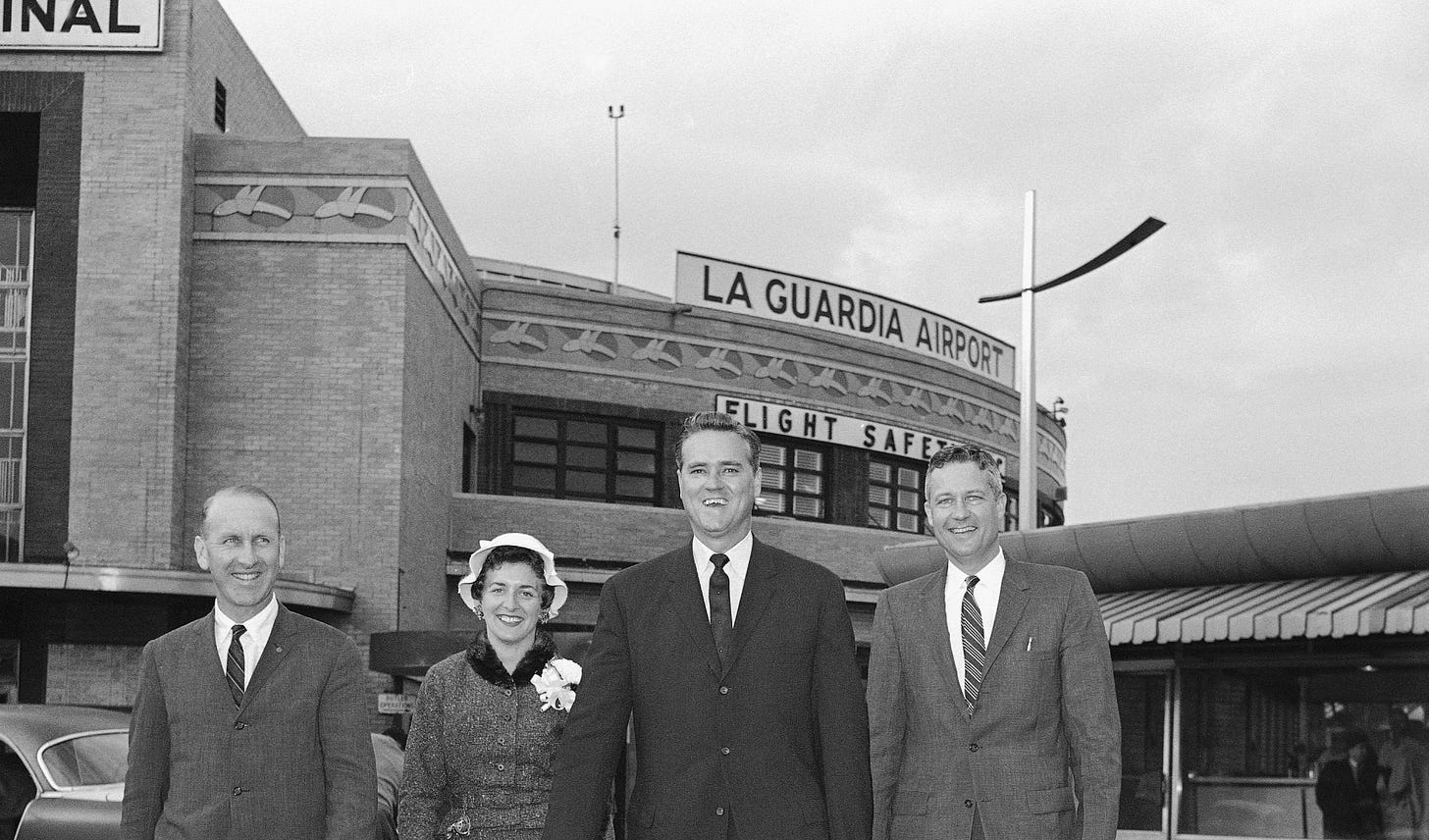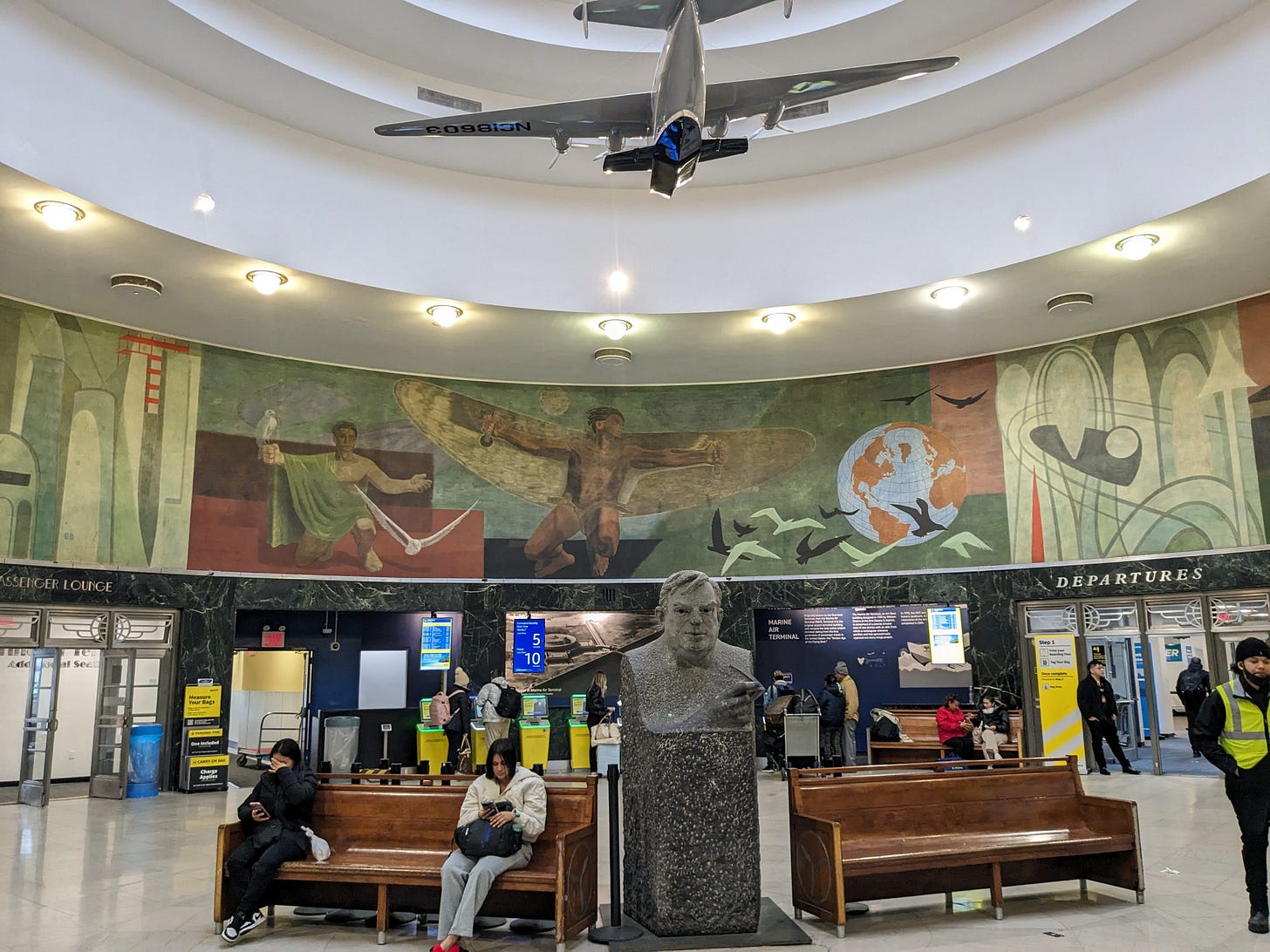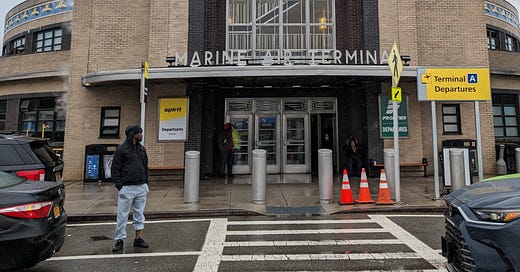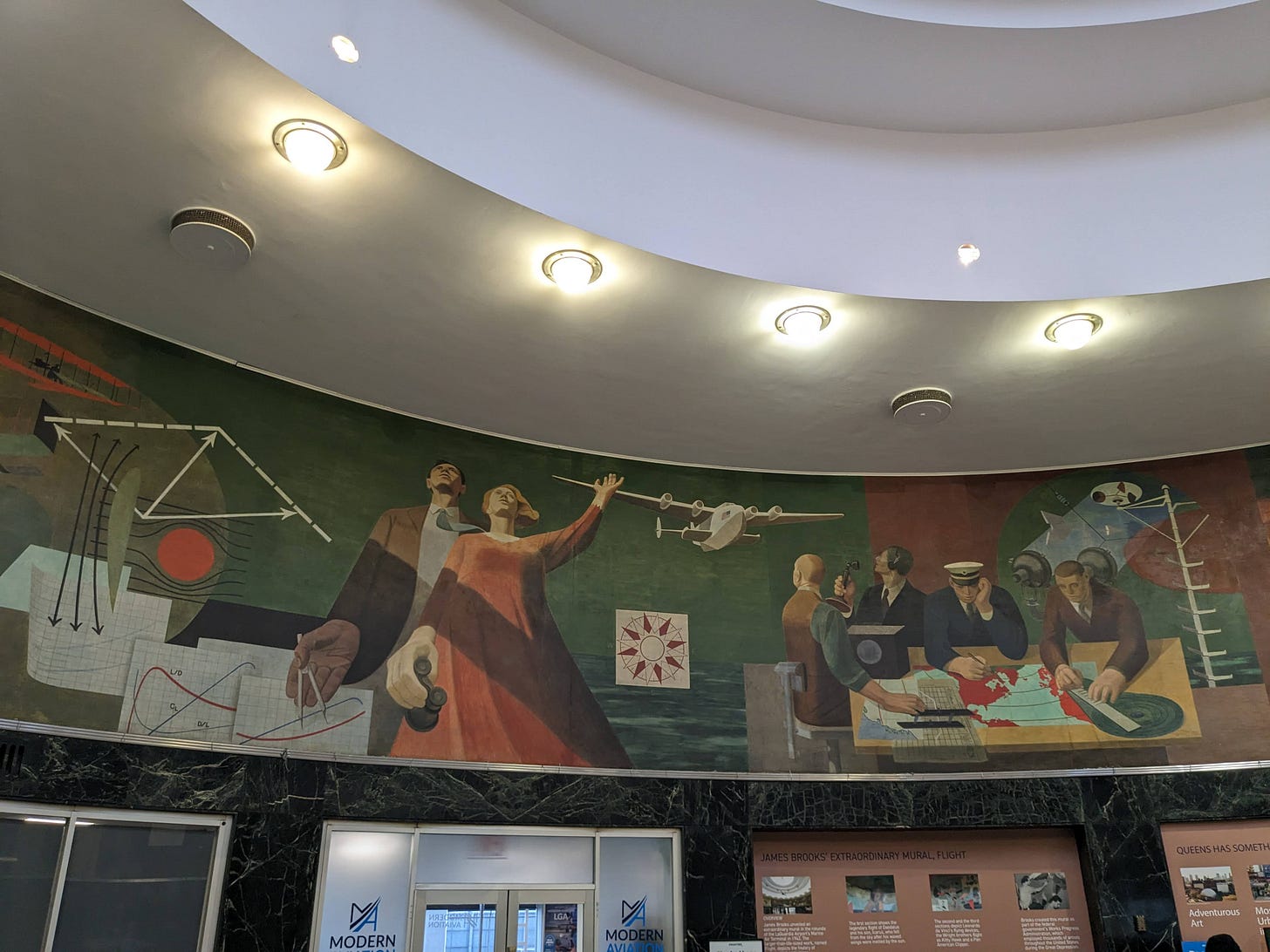Rennovations on LaGuardia Airport began in 2016, and finished up in 2022. Go inside, and you’ll see a sleek, bright, efficient travel hub with a Mighty Quinn’s barbeque inside. You would never suspect it was a place Joe Biden once compared to “a third world country.” This transformation was dubbed “a Queens miracle.” The depressing, crumbling interiors of LaGuardia’s various terminals have finally been laid to rest—replaced with bright flourescent lights and colorful, singing fountains. That is, except for Terminal A.
This is all of LaGuardia Airport’s Terminal A. It’s the oldest airport terminal in New York, and it’s about the size of an elementary school. Also known as the Marine Air Terminal, Terminal A was built in the 1930s and was originally home to New York’s seaplane hangars (which are now administrative buildings and storage).

In 2022, LaGuardia Terminals B and C shed their former shells, and burst out of their scaffolded cucoons completely anew. LaGuardia Terminal A also recieved attention during The Great Rennovation, but their results had almost the reverse effect—placing the terminal even more squarely in the past. Its most major change was the completed restoration of an old mural, which was painted over (censored, some say) in 1952 at the height of the McCarthy era.

The rotunda at the entrance of the terminal is decorated with a massive 360 degree mural depicting the history of humans’ relationship with flight. It was a little too commie for the ‘50s because its style seemed to be influenced by socialist realism, even though there weren’t any communist sentiments overtly expressed in the piece. (Fellas, is it communist to celebrate working together to achieve impressive technological advancements using federal funds?) In 1980, Terminal A became an official New York landmark, and it is now protected from demolition.
I could write more about this gorgeous mural, the historic architecture of Terminal A, or more of its weird history. I’ll direct you to some interesting resources to read instead, because that’s not what I’m here to write about.
I’m here to write about the Yankee Clipper.
***
In 2017, I walked into Terminal A for the first time, picking up some prospective Columbia students visiting campus. I was too early, so I wandered into the room to my left, enticingly labeled “RESTAURANT” and accessible pre-security. It had a deli-style buffet, vending machines, and a large self-seating area with aluminium chairs and shiny surfaces. They served diner food and NYC sandwich classics, like a bacon egg and cheese on a roll or a meatball hero. It seemed strangely empty. I got a slice of marble pound cake wrapped in plastic, and sat in a chair watching planes take off.
This is the sort of diner scene I find incredibly charming: a place for anyone and everyone to show up and get something familiar to eat. A home base that grounds you in the middle of a long and disorienting journey. The food does not and should not surprise, it is simple and edible. It’s a hug from someone familiar, a reminder that anywhere you go, there is someone that knows you. The warm food is cooked according to a universal understanding of how to make scrambled eggs and coffee, but it is made with human hands and therefore impercepibly unique in each place one visits. For the Yankee Clipper in particular, the unbrandedness of the place really does it for me. “Restaurant.” This is a place you go to eat food. You don’t really have much of a choice, so we’ll do our best to make it easy for everyone who comes through here. We’re not selling you on a consumer identity, or an experience. We’ll just have what you need.
The Yankee Clipper was Terminal A’s restaurant, available to anyone whether they were boarding a flight or not. A few weeks ago, I went to Terminal A to see it again.
When I arrived, I saw that the Yankee Clipper was gone. Instead, “RESTAURANT” had been replaced with “Passenger Lounge,” and inside we found a CIBO Express kiosk and some airport seats, like a gate waiting area with no gate.
I couldn’t bring myself to take a picture of its interior. It was devastating.
According to the official landmark designation report of Terminal A, the protected areas include “the circular main space to the depth of the opening reveals, and the fixtures and interior components of these spaces.”
I assumed that in a fit of capitalistic greed and CIBO Express-related corruption, rennovators took this vague and confusing language that protects “interior components” but not the use of the space, and gutted the Yankee Clipper. However, the real story about why the Yankee Clipper is gone is much stranger.
***
In 1988, Rocky Maniello, a 5’5’’ pizza counter employee with a big personality, sold his house in Whitestone to open a restaurant at LaGuardia Airport. It would be called the Yankee Clipper, and it became a well-loved spot known to the New York City airport restaurant scene, frequent flyers, and locals alike. He even served lunch to kids visiting the airport on school trips, carrying baked ziti onto a Boeing 727 where the class ate. While he was opening the Yankee Clipper, Maniello also started opening a swath of other airport restaurants, mostly in JFK, and was a well-known fixture amongst internal airport personnel.
In 2019, Maniello and his son were convicted of operating an extensive tax fraud scheme under their restaurants’ LLC, with a $13 million settlement. The investigation was called “Operation Greased Runway,” and it closed the Yankee Clipper for good. But by that point, Maniello had already been dead for two years, having suffered a paralyzing stroke in 2017. When he died, even though the investigation started while he was still alive, he was very well-loved. He simultaneously was a massive airport personality who fed thousands, and the ringleader of a tax fraud scheme that a former New York State Attoney General called “disgraceful.” Rocky was an original. He and his weird diner are missed.
I don’t know how to describe this feeling about diners. They’re a dime a dozen, but they’re all SO UNIQUE. Every choice is a result of some human being making it, and there are no focus groups or well-tested strategic decisions to smooth out rough edges. Some restaurants have resources, names, and concepts that are intended to make them stand out. But to be a diner, you must blend in, at least a little.
When you see what’s in there, at first it’s all the obvious choices. Big menus, cushy booths, and hamburgers. But between the staples holding everything in a diner together, there are pores where small pockets of intentional or unintentional creative freedom can survive. If you look at the weird menu options you might come across a “Nancy’s sandwich” or a really odd logo that scares young children. Where did those choices come from? If you look hard enough, you start to see the personalities of the people who run the place.
Clipperless, we drove to Buccaneer Diner, the pirate-themed restaurant where we thought maybe Nic’s parents had ended up for their first meal after immigrating to the United States. Isabella was already wondering the same, saying to herself, “I have to find out where my family flew in from.” Was it LaGuardia? If so, which terminal?
The Buccanner Diner recieved us warmly—with a non-uniformed parking attendant who looked to be in his mid-60s screaming at me in the rain to park in a handicapped spot. “IT’S FINE,” he yelled. “YOU’RE SAFE.”
Over lunch, we found out that Nic’s parents flew in through JFK, so this couldn’t have been the place. But we sat there imagining what it would be like if it had, chewing through our eggs, bread, and sausage. Our waitress refused to write our huge order down, and let us have the egg cream she forgot on the house.
A diner is a good place to be receieved. It’s very grounding if you’re focusing on other things, like orienting yourself in a strange new place or meeting with old friends. But looking closely and going outside of yourself in these places is also rewarding. The other human beings in your midst make themselves known.
Leaving Buccaneer, we laughed at a storefront donning a large awning that read “BUTTS REAL ESTATE.” The parking attendant scoffed, and said he knew Butts. His brother died in the 90s, and he’d been doing real estate for over 30 years. Of course.
I hope I get to go back to Buccaneer someday, when I need it after I come home from the airport. Whether or not the same people are behind the counter, whether they quit or were posthumously convicted of tax fraud or just died, I like inhabiting the place they once gave life to. I like eating their tired old recipes. I like analyzing their placemats and awnings and signage. And if a mural is painted over, I’d keep coming back until someone uncovered it again, sharing its beauty after a long time away.












rocky was an ORIGINAL!